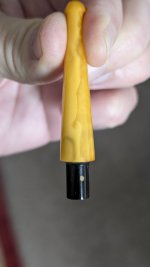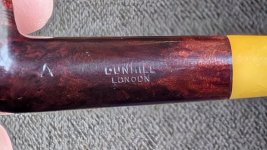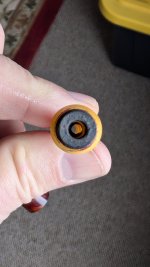Revisiting A Closed Topic —
In August 2020, I posted about a cased 1920 amber-stemmed Dunhill billiard I had purchased which lacked the characteristic White Spot on the stem. It was originally purchased from Mappin & Webb, a Parisian jeweler. A friend, Anthony Sacco, mentioned that he thought he had seen a pair of early amber-stemmed Dunhills with the spot on the tenon, rather than on the exterior of the mouthpiece. Fred Hanna told me that he, too, had seen one. Rich Esserman said that he had never seen nor heard of such a pipe, but that since the registration on this early pipe was perfect, he felt it was probably original. Unfortunately, the stem on my pipe wasn’t budging.
Being amber and not knowing for certain whether the tenon was Vulcanite or bone, I didn’t dare try to exert much force. So, for the last four years, I’d occasionally try twisting the stem, but it wasn’t moving. Yesterday, I decided to try a trick I’ve used in the past with restorations that have stuck stems. Sometimes, tar can build up between the shank and the mouthpiece, forming a sort of glue. I didn’t think that was likely in this case because the pipe was lightly smoked, but I tried anyway. I used Glide dental floss, which is made from GoreTex. It’s very strong, slippery, and thin. In spite of there being no apparent gap, the floss made it in. I worked it around and after removing it, I tried a little twist and…”click”. Not the sound of breakage, but a tiny bit of movement. Maybe 1/2-degree of rotation, but it was something.
I put the pipe in its Ventage case and sealed it in a Ziploc, then put it in my freezer. This was something I‘d tried several times before, but with no luck. This morning, I removed it from the freezer and gave it a twist. Maybe 5 degrees of rotation now and there was now a gap of about 1/16”. That certainly suggested it was a Vulcanite tenon, since it didn’t tighten when I reversed it. I scratched at the tenon using a dental instrument and it didn’t seem hard, like bone. At this point, I had no choice but to apply more force that I’d been willing to use in the past, but the stem needed to either go back in or come out. Plus, I now had 90% certainty that it was a vulcanite tenon. As gently as possible, I twisted and voilà, it was out.
What did I find? A spot! Like many vintage Dunhills, the white spot is now a buttery yellow, but a spot. One thing that surprised me was that I had expected that if there was a dot, it would have been at 12 o’clock. I have understood that originally, the dot was to assist owners with orienting their stems properly, rather than rotated 180 degrees. This one is at about 2 o’clock. So, maybe the white spot has always been just a trademark after all.






In August 2020, I posted about a cased 1920 amber-stemmed Dunhill billiard I had purchased which lacked the characteristic White Spot on the stem. It was originally purchased from Mappin & Webb, a Parisian jeweler. A friend, Anthony Sacco, mentioned that he thought he had seen a pair of early amber-stemmed Dunhills with the spot on the tenon, rather than on the exterior of the mouthpiece. Fred Hanna told me that he, too, had seen one. Rich Esserman said that he had never seen nor heard of such a pipe, but that since the registration on this early pipe was perfect, he felt it was probably original. Unfortunately, the stem on my pipe wasn’t budging.
Being amber and not knowing for certain whether the tenon was Vulcanite or bone, I didn’t dare try to exert much force. So, for the last four years, I’d occasionally try twisting the stem, but it wasn’t moving. Yesterday, I decided to try a trick I’ve used in the past with restorations that have stuck stems. Sometimes, tar can build up between the shank and the mouthpiece, forming a sort of glue. I didn’t think that was likely in this case because the pipe was lightly smoked, but I tried anyway. I used Glide dental floss, which is made from GoreTex. It’s very strong, slippery, and thin. In spite of there being no apparent gap, the floss made it in. I worked it around and after removing it, I tried a little twist and…”click”. Not the sound of breakage, but a tiny bit of movement. Maybe 1/2-degree of rotation, but it was something.
I put the pipe in its Ventage case and sealed it in a Ziploc, then put it in my freezer. This was something I‘d tried several times before, but with no luck. This morning, I removed it from the freezer and gave it a twist. Maybe 5 degrees of rotation now and there was now a gap of about 1/16”. That certainly suggested it was a Vulcanite tenon, since it didn’t tighten when I reversed it. I scratched at the tenon using a dental instrument and it didn’t seem hard, like bone. At this point, I had no choice but to apply more force that I’d been willing to use in the past, but the stem needed to either go back in or come out. Plus, I now had 90% certainty that it was a vulcanite tenon. As gently as possible, I twisted and voilà, it was out.
What did I find? A spot! Like many vintage Dunhills, the white spot is now a buttery yellow, but a spot. One thing that surprised me was that I had expected that if there was a dot, it would have been at 12 o’clock. I have understood that originally, the dot was to assist owners with orienting their stems properly, rather than rotated 180 degrees. This one is at about 2 o’clock. So, maybe the white spot has always been just a trademark after all.






Last edited by a moderator:















